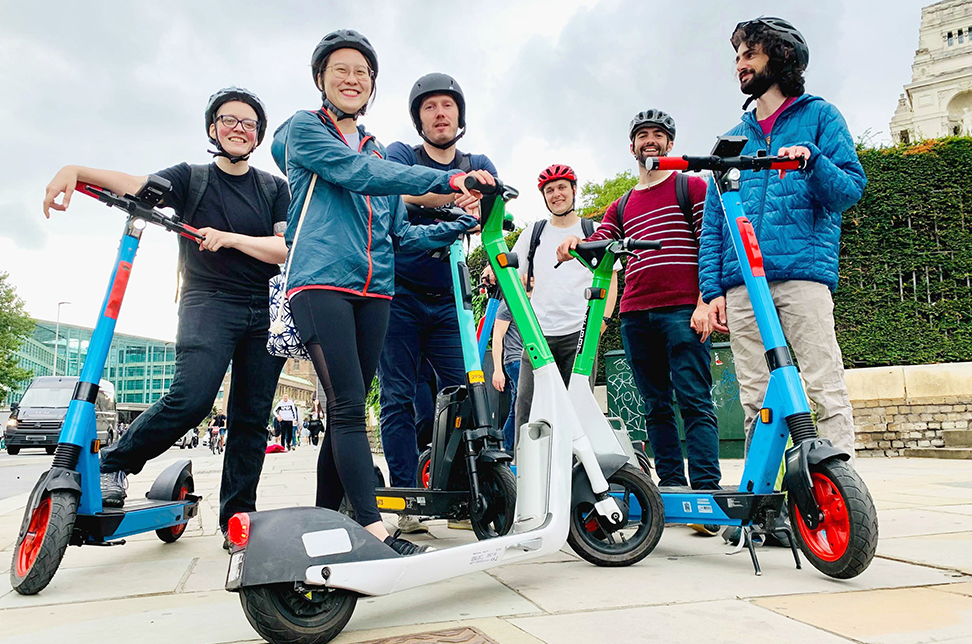- Viva’s computer vision monitoring is unique in its ability to provide near-real time insights into e-scooter behaviors and multimodal interactions
- This comprehensive e-scooter data should underpin the assessment of e-scooter trials
- Data-led decision-making is crucial to enabling e-scooters to reach their potential as a safe, sustainable and attractive transport mode
The road to safe and sustainable e-scooter integration with Viva
It’s now possible to gather accurate, comprehensive, continual data on e-scooter behaviors with Viva’s AI-powered computer vision sensors.
Our sensors have unrivalled versatility and the highest levels of accuracy on the market. They’re increasingly being used to gather data on emergent transport classifications and behaviors, including e-scooters.
Evaluating e-scooter trials
Accurate insights on how traffic behaves and interacts helps authorities to understand how transport systems and road users are adapting to the introduction of e-scooters with real-time 24/7 multimodal data.
Our sensors capture both rental and privately owned sectors of the e-scooter market. Only with this all-inclusive e-scooter data can transport planners create a safe, sustainable and inclusive multimodal transport network that supports both Net Zero and Vision Zero goals.
The evaluation of e-scooter trials aims to build strong evidence on the impact and benefits to the public, as well as understanding how the local transport system is working. Local authorities participating in the trials will be expected to gather data and address specific points, as mentioned on the government’s website. Some of these points are listed below, including suggested features of our computer vision solution that would be perfect for the job.
Road safety
Gain an in-depth understanding of the road safety implications for e-scooters and their fellow road users.
Analyse speed and near miss datasets to understand the implications of e-scooter volumes and behaviors on the safety of vulnerable road users, and the safety risks vehicular traffic pose to e-scooters.
Use these insights to guide safety interventions, develop e-scooter policy, educate e-scooter riders on best practice and raise e-scooter road safety awareness.

Modal shift
Quantify the extent of modal shift and network modal share.
Use long-term multimodal classified counts data to assess modal shift over time and establish current modal share.
These insights enable data-led infrastructure planning and development, the deployment of tactical road safety schemes and interventions, and scoping strategic locations for shared e-scooter hubs and parking.

Congestion
Understand the impact of e-scooter hubs on surrounding traffic flow.
Aggregate zonal occupancy, journey time and origin-destination data to understand how e-scooter hubs impact congestion and traffic flow on surrounding roads.
Use this data to identify problem areas of the network and strategic locations for e-scooter hubs and parking.

The e-scooter challenge
Transportation is diversifying. Transport planners and network managers across the UK are faced with the task of strategically integrating e-scooters into urban infrastructure.
The popularity of e-scooters goes from strength to strength. London’s e-scooter trial recorded its 1 millionth trip in May 2022. They are a green transport alternative to the car, can address the first/last mile problem and form the crux of the Mobility as a Service movement.
But they also pose one of the most contentious road safety challenges of the 21st century. There were 11 deaths involving privately owned e-scooters in 2021 and nearly 900 casualties from collisions involving e-scooters, and many of these did not involve another vehicle.
In the aftermath of the pandemic, it’s vital that a long-term approach is taken to optimize urban areas for this new era of transport. The safety of all road users must be at the forefront. This is a challenge that requires evidence-based decision-making.
The Impact of the Pandemic on Active Transportation in 2021
Learn more about the pandemic’s impact on modal shift in our recent report
Data on e-scooter trials will inform e-scooter legislation and the strategic roll-out of shared e-scooter schemes. It will also provide guidance on the proposed legalisation of privately owned e-scooters as set out in the latest Transport Bill. To maximise the value of e-scooter trial data, computer vision e-scooter insights are vital.
Learn more about how Viva computer vision insights can support the safe integration of e-scooters and micromobility – head to our online resource Evaluating Modal Shift with Data-Insights.
Here you will find:
- Viva’s accuracy and validation process and range of datasets
- Modal shift in the aftermath of the pandemic
- Your top modal shift questions answered
- Modal shift monitoring and assessment to support funding bids
- Case studies to learn about our tech in action
Working on a project that needs e-scooter behavior insights?
We’d love to hear from you.
Get in touch here
You might also be interested in:
Our Solutions | Viva Technology | Other News & Case Studies | About us
Like our content? Sign up to our newsletter and receive the latest updates in your inbox.










